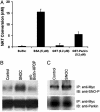Nitrosative stress linked to sporadic Parkinson's disease: S-nitrosylation of parkin regulates its E3 ubiquitin ligase activity
- PMID: 15252205
- PMCID: PMC490016
- DOI: 10.1073/pnas.0404161101
Nitrosative stress linked to sporadic Parkinson's disease: S-nitrosylation of parkin regulates its E3 ubiquitin ligase activity
Erratum in
- Proc Natl Acad Sci U S A. 2004 Sep 21;101(38):13969
Abstract
Many hereditary and sporadic neurodegenerative disorders are characterized by the accumulation of aberrant proteins. In sporadic Parkinson's disease, representing the most prevalent movement disorder, oxidative and nitrosative stress are believed to contribute to disease pathogenesis, but the exact molecular basis for protein aggregation remains unclear. In the case of autosomal recessive-juvenile Parkinsonism, mutation in the E3 ubiquitin ligase protein parkin is linked to death of dopaminergic neurons. Here we show both in vitro and in vivo that nitrosative stress leads to S-nitrosylation of wild-type parkin and, initially, to a dramatic increase followed by a decrease in the E3 ligase-ubiquitin-proteasome degradative pathway. The initial increase in parkin's E3 ubiquitin ligase activity leads to autoubiquitination of parkin and subsequent inhibition of its activity, which would impair ubiquitination and clearance of parkin substrates. These findings may thus provide a molecular link between free radical toxicity and protein accumulation in sporadic Parkinson's disease.
Figures





References
-
- Mayer, R. J., Lowe, J., Lennox, G., Doherty, F. & Landon, M. (1989) Prog. Clin. Biol. Res. 317, 809-818. - PubMed
-
- Bence, N. F., Sampat, R. M. & Kopito, R. R. (2001) Science 292, 1552-1555. - PubMed
-
- Goldberg, A. L. (2003) Nature 426, 895-899. - PubMed
-
- Perutz, M. F. & Windle, A. H. (2001) Nature 412, 143-144. - PubMed
Publication types
MeSH terms
Substances
Grants and funding
LinkOut - more resources
Full Text Sources
Other Literature Sources
Medical

